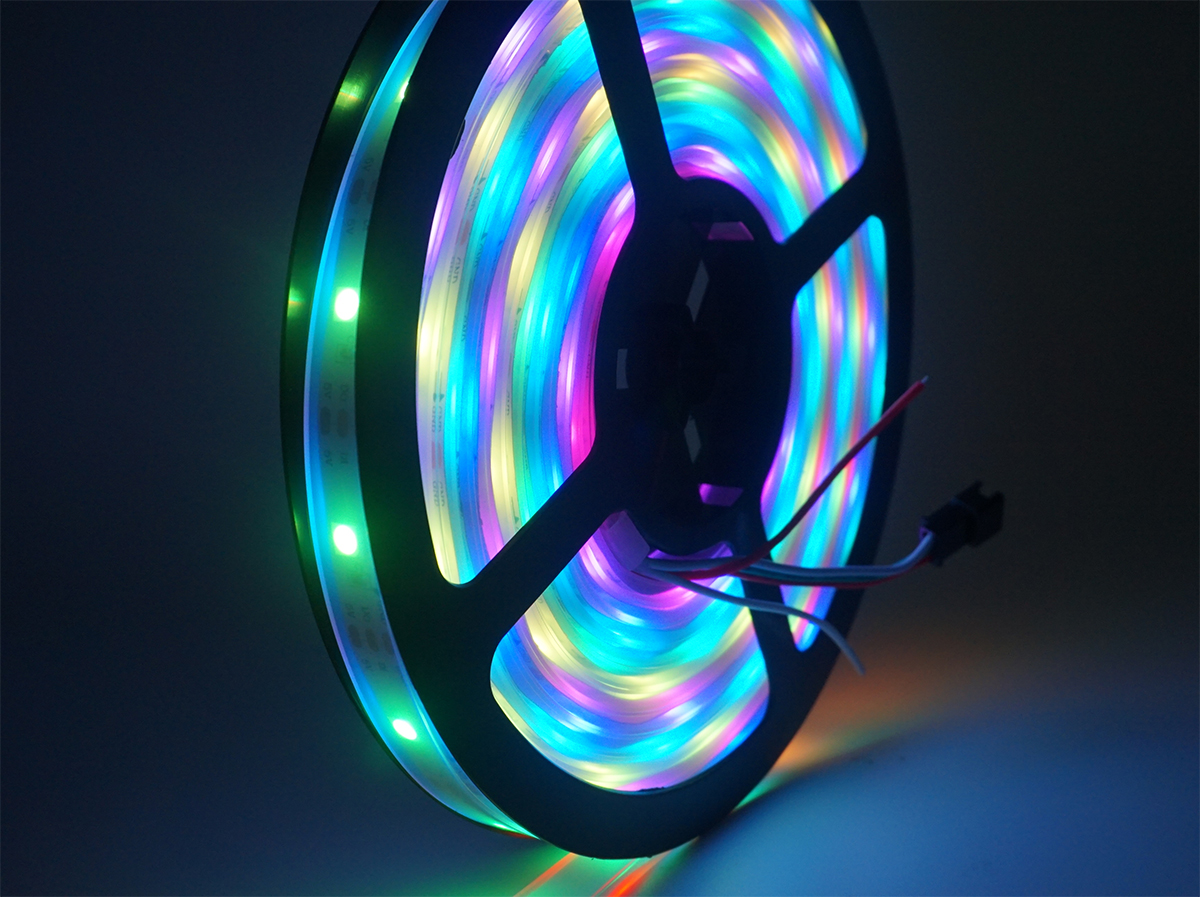What is a smart LED strip light
A smart LED strip light is a connected lighting device that allows access and control via IP-capable devices such as smartphones, and/or can interact with intelligence provided by software in the cloud. It’s WiFi, Bluetooth, Zigbee or Z-Wave enabled for remote operation through the use of iOS or Android smartphone apps. It may also work with voice-enabled home automation platforms for hands-free lighting control. Just as the light fixtures can be optimized in styling and appearance to reinforce the design aesthetics of a space, they can be designed to provide highly controllable lighting that enhances the personality and complement the various functions of the space. Smart light strips put creativity in the palm of your hand and deliver comfort and convenience in an easy-to-use, intuitive fashion.
Infinite possibilities for playing with light
Flexible LED strip lights can be bent to fit anywhere, cut or extended to any length, and come with adhesive backing for peel-and-stick mounting. The design freedom and installation possibilities are almost limitless. Building intelligence and wireless network connectivity into LED strips opens up a huge new range of possibilities. It allows lighting to be customized, scheduled and controlled with smartphones, anytime and anywhere, for every occasion and activity. Smart lighting delivered by digital LED strips controllable over the Internet is more than just about on/off switching and dimming control without physically touching a switch. Smart LED strip lights can illuminate in your choice of colors, whether it’s for human centric lighting or to transform your space with incredible atmospheres. With LEDs arranged in a linear array, these smart lights are particularly suited to lighting applications where breathtaking color changing effects are desired. Sync lights with various color combinations in dynamic rhythms to the beat of your favorite music, movies and games for immersive effects. Trigger your lights based on applets and scripts available on cloud-based task automation platforms such as If This Then That (IFTTT).
Digital LED control
A smart LED strip light is usually a digital type flexible LED strip which incorporates individually addressable LEDs for a sophisticated presentation. Conventional LED strips are referred to as analog-type strips because the LEDs used on the strips cannot be controlled independently. All LEDs that are mounted on the strip or connected in the same circuit are operated by a master controller or dimmer, which means they respond to control signals simultaneously in the same manner and the entire strip is always the same color or color combination at any given time. Smart LED strip lights in this configuration can be DMX controlled to provide additive color mixing on the string level. But they offer limited color patterns and cannot produce “moving” or “chasing” effects. Digital LED strips, in contrast, allow for selective control of individual LEDs or discrete strings of LEDs. The output (color, intensity) of different LEDs or LED strings on a digital light strip can be varied simultaneously to create intricate color patterns and dynamic effects that appear to move across sequences of the strip.
Individually addressable LEDs
Digital LED strip lights thrive on the use of individually addressable LEDs. An addressable LED comes in the form of a standard SMD LED package such as a 5050, 3535, or 2020 LED. Unlike a non-addressable LED that relies on external control circuitry for on/off and dimming control, an addressable LED has an embedded controller IC chip that can communicate with a master controller through the SPI (Serial Peripheral Interface) protocol. Typically, the addressable LED is an RGB package which contain three diodes (red, green, and blue). Each of the diodes inside the package can be assigned a value from 0 to 255 in decimal for individual pulse-width modulation (PWM) brightness control by the companion controller IC. Through additive color mixing, an RGB LED can technically produce a total of 16,777,216 colors. Red, green, and blue LED chips are made from different semiconductor materials (AlInGaP for red diodes, InGaN for blue and green diodes). They exhibit different operational characteristics. Accurate dimming of three component LEDs is critical to production of predictable colors in additive color mixing applications. Therefore diode-level control that is unique to addressable LEDs is a huge advantage. Addressable LEDs are also available in RGBW packages. Adding a white LED to an RGB LED can broaden the color gamut and allows to create better-quality whites compared to RGB.
Strip fabrication
A smart LED strip light is an assembly of SMD LEDs on a flexible printed circuit (FPC) board. The LEDs are connected in parallel, which is the typical wiring configuration of an individually addressable LED strip. An alternative configuration is to wire multiple LED strings in parallel. Each LED string includes two or more addressable or non-addressable LEDs connected in series. The LEDs of a string are controlled collectively, and thus a LED string is sometimes called a color zone. The LED strip can be cut every independently wired LED or LED string. The FPC is fabricated on a polyimide (PI) film which outperforms other substrate materials in providing both flexibility, durability, resistance to thermal or chemical damage, and structural integrity for LED strips. The circuit traces are made from rolled and annealed (RA) copper foils which have superior tear strength and allow for formation of high reliability solder joints. The copper traces should be properly dimensioned to reduce the impact of voltage drop and provide an adequate thermal path to dissipate heat generated in the LED junction. Tight current regulation and LED binning are vital to achieving uniform color and intensity over the entire run. In analog LED strips, current regulation is provided by resistors or constant current driver ICs that are placed in series with each LED or LED string. Addressable LEDs have built-in programmable constant current control. Some controller ICs feature voltage-independent color and brightness control. LEDs are binned to have chromaticity, lumen output, and forward voltage within a tight set of bounds.
Light controller
A smart LED strip light is connected to a light controller which communicates with the LEDs and tells them what intensity, color and rate of change they should follow. The controller is equipped with a wireless transmitter/receiver which connects the controller to a gateway, router or hub via a communication protocol such as ZigBee, Z-Wave, Bluetooth and WiFi. Wireless control via ZigBee and Z-Wave requires compatible hub or bridge to pair the light controller. WiFi enabled light strips are easy to configure because no hub is required. However, WiFi is less robust in terms of scalability, interoperability, reliability, energy efficiency and security features when compared with mesh networks such as ZigBee and Z-Wave. Through an application software known as a mobile app installed on a smartphone, preprogrammed scenes and dynamic effects stored in the light controller can be activated, custom colors and color-changing effects can be created. With voice control capability, smart light strips can be operated via voice commands to Amazon Alexa, Google Assistant, Apple HomeKit, or other cloud automation platforms. The light controller is wired between the LED strip and power supply. Smart LED strip lights utilize a 5V, 12V, or 24V DC electrical power which can be provided by a plug-in power supply, a battery bank, or a USB power source.



















Loading...